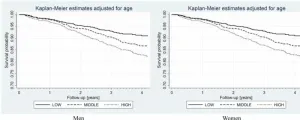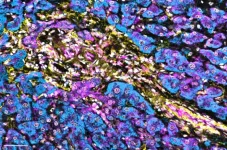(Press-News.org) Glioblastoma is the most common – and the most malignant – primary brain tumour in adults. It’s aggressive and incurable. Even with treatment including surgical removal and chemotherapy, the median survival for patients is just 18 months.
Now, innovative new research led by Dr. Arezu Jahani-Asl, Canada Research Chair in Neurobiology of Disease at the University of Ottawa, provides highly compelling evidence that a drug used to slow the progression of the disease ALS shows promise in suppressing the self-renewing cancerous stem cells that challenge the present standards of care for these lethal grade 4 brain tumours.
Her team’s findings could prove highly impactful because brain tumour stem cells (BTSCs) are at the very core of therapeutic resistance and tumour recurrence in glioblastoma, a devasting and treatment-resistant type of cancer that impacts four per 100,000 people in Canada.
Indeed, discovering ways to effectively target these rare populations of highly resistant cells could have major implications for global efforts to combat brain cancer, according to Dr. Jahani-Asl, associate professor in the Department of Cellular and Molecular Medicine and a member of the uOttawa Brain and Mind Institute.
Here’s what the uOttawa-led team found: The drug edaravone (brand name Radicava) inhibits the self-renewal and proliferation of brain tumour stem cells so repurposing the drug may prove to be a potent weapon against glioblastoma. They reported their findings in the journal Stem Cell Reports.
“We show that edaravone specifically targets cancer stem cells and is particularly effective in combination with ionizing radiation,” she says. “The study suggests that edaravone in combination with ionizing radiation can be effective in eradicating cancer stem cells, and thus is expected to decrease the chance of resistance to therapy and recurrence in glioblastoma patients.”
Ionizing radiation is a type of radiation that is used in cancer therapy to kill or inhibit the growth of malignant cells. Next steps for the researchers include writing a protocol on the best ways to optimize edaravone drug dosage in combination with ionizing radiation and chemotherapy.
Repurposing existing marketed drugs already approved for human use is an increasingly popular strategy of battling different types of cancer cells. And compounds that have already been proven safe could potentially advance swiftly to clinical trials. Since edaravone is an approved compound that has already been shown safe in humans, Dr. Jahani-Asl says repurposing the drug and its translation for glioblastoma is “very promising.”
Edaravone was approved by the U.S. Food and Drug Administration in 2017 to treat ALS, and Health Canada approved the drug’s oral formulation in 2022. It’s also used to treat stroke.
Before the completed study provided compelling evidence that edaravone sensitizes glioblastoma tumours to radiation therapy in animal models, the research team conducted gene expression analysis in patient-derived brain tumour stem cells in the absence and presence of the drug.
“We found significantly deregulated gene panels related to stemness and DNA repair mechanisms which was the spark to begin a new major line of investigation,” Dr. Jahani-Asl says.
Achieving new insights into BTSC regulation is at the forefront of efforts to battle glioblastoma, and Dr. Jahani-Asl is an international leader in this effort. Her research program at the uOttawa Faculty of Medicine is centered on developing novel therapeutic strategies for complex and devastating brain diseases.
Any new drug for glioblastoma is expected to be used in combination with the present standard treatments which includes ionizing radiation and chemotherapy.
“Our goal is now to try to optimize dosage for a safe therapeutic window,” Dr. Jahani-Asl says. “Once we establish a dose that is safe for use in combination therapy, we will be well equipped with the knowledge to move this forward to clinic.”
END
Repurposing drug shows promise in fighting aggressive brain tumours: uOttawa study
Innovative research from the University of Ottawa drug used to slow the progression of the disease ALS shows promise in suppressing the self-renewing cancerous stem cells that challenge the present standards of care for these lethal grade 4 brain tumours
2024-10-17
ELSE PRESS RELEASES FROM THIS DATE:
New initiative to fuel neuroscience and aging research
2024-10-17
Demonstrating its commitment to excellence as a member of the Association of American Universities and number one in the state for National Institutes of Health (NIH) funding, the University of Miami has pledged to invest more than $30 million to bolster basic science research that will target neuroscience and aging, some of the most complex conditions confronting the United States population, including in South Florida.
The investment over the next five years will create a new program in ...
WashU researchers use genetics to find psychopathology risks
2024-10-17
When trying to understand how genetic influences factor into youth behavior, researchers at Washington University in St. Louis have taken the “big trawl” approach, casting their net wide to pull in all the measured traits, behaviors and environments that make up who we are and examine associations with the genetic building blocks comprising risk for mental health problems.
This cutting-edge methodology has turned up valuable new insights into factors related to psychopathological genetic risk, ...
Fibroblast growth factor 21 and survival in the elderly: Polsenior2 study results
2024-10-17
“Of note, participants with high serum levels of FGF21 more frequently had metabolic complications, such as hypertension, obesity, diabetes, hypercholesterolemia, and hypertriglyceridemia.”
BUFFALO, NY- October 17, 2024 – A new research paper was published in Aging (listed by MEDLINE/PubMed as "Aging (Albany NY)" and "Aging-US" by Web of Science), Volume 16, Issue 19 on September 18, 2024, entitled, “Fibroblast growth factor 21 inversely correlates with survival in elderly population – the results of the Polsenior2 study.”
As ...
Plankton balloon to six times their size in newly discovered mode of oceanic travel
2024-10-17
Many plankton journey from the cold, dark depths of our oceans to the surface, only to eventually drift down again into the darkness in a perpetual rhythm. Yet, how single-celled phytoplankton, most of which have no appendages to help them swim, make this pilgrimage has remained a mystery. In a paper publishing October 17 in the Cell Press journal Current Biology, researchers describe a species of bioluminescent phytoplankton, called Pyrocystis noctiluca, that balloons to six times their original size of a few hundred microns. This massive inflation allows the plankton to journey up to 200 meters toward the ocean’s surface to capture sunlight, then ...
Repurposing drugs to eliminate cellular origins of brain tumors
2024-10-17
Glioblastomas are aggressive brain tumors with a median survival time of less than 22 months despite standard therapy including surgery, irradiation, and chemotherapy. It has become clear in recent years that not all cells within the brain tumor have an equal potential to divide and drive tumor growth. As such, a fraction of tumor cells called brain tumor stem cells (BTSCs) are thought to be the primary origin of tumor re-growth after surgery in addition to being resistant to standard treatments including chemotherapy and irradiation. Therefore, targeting BTSCs may be a way to effectively treat glioblastomas.
In an effort to rapidly identify ...
Biomarker may predict immunotherapy response in liver cancer
2024-10-17
It may soon be possible to determine which patients with a type of liver cancer called hepatocellular carcinoma would benefit from immunotherapy, according to a preclinical study by Weill Cornell Medicine investigators.
The study, published Oct. 17 in Molecular Cell, provides new insights into a pair of proteins, called p62 and NBR1, and their opposing functions in regulating the interferon response in hepatic stellate cells, a critical immune component in the liver’s fight against tumors. The study demonstrates that high levels of the immune-suppressing NBR1 in these specialized cells may identify patients who are unlikely to respond ...
Prevalence of glaucoma among US adults in 2022
2024-10-17
About The Study: This meta-analysis found that an estimated 2.56% of people 40 years or older have glaucoma, slightly more than estimated by previous studies. Black individuals are disproportionately affected. Prevalence estimates at the state and county level can help guide public health planning.
Corresponding Author: To contact the corresponding author, Joshua R. Ehrlich, MD, MPH, email joshre@umich.edu.
To access the embargoed study: Visit our For The Media website at this link https://media.jamanetwork.com/
(doi:10.1001/jamaophthalmol.2024.3884)
Editor’s ...
Effect of electric fans on body core temperature in older adults exposed to extreme indoor heat
2024-10-17
About The Study: Electric fan use did not lower peak core temperature in older adults exposed to extreme indoor heat. Reductions in end-exposure core temperature and heart rate were observed, but they were small and of questionable clinical importance. Neither exceeded previous suggestions for clinical significance. Consistent with recent modeling, these data do not support fans as an efficacious standalone cooling intervention for older adults in hot indoor environments (>33-35 °C).
Corresponding Author: To contact the corresponding author, Glen P. Kenny, PhD, email gkenny@uottawa.ca.
To ...
Buprenorphine/naloxone vs methadone for the treatment of opioid use disorder
2024-10-17
About The Study: Individuals receiving methadone had a lower risk of treatment discontinuation compared with those who received buprenorphine/naloxone. The risk of mortality while receiving treatment was similar between medications.
Corresponding Author: To contact the corresponding author, Bohdan Nosyk, PhD, email bnosyk@sfu.ca.
To access the embargoed study: Visit our For The Media website at this link https://media.jamanetwork.com/
(doi:10.1001/jama.2024.16954)
Editor’s Note: Please see the article for additional information, including ...
Astrobiology: Potential microbial habitats in Martian ice
2024-10-17
Dusty ice exposed at the surface of Mars could provide the conditions necessary for the presence of photosynthetic life, according to a modelling study. The findings, published in Communications Earth & Environment, suggest that ice deposits located in the planet’s mid-latitudes should be a key location in any search for life on Mars.
High levels of harmful ultraviolet radiation from the Sun make current life on the surface of Mars almost certainly impossible. However, a sufficiently thick layer of ice can absorb this radiation and could protect cells living below its surface. Any life in these conditions ...
LAST 30 PRESS RELEASES:
Brain stimulation device cleared for ADHD in the US is overall safe but ineffective
Scientists discover natural ‘brake’ that could stop harmful inflammation
Tougher solid electrolyte advances long-sought lithium metal batteries
Experts provide policy roadmap to reduce dementia risk
New 3D imaging system could address limitations of MRI, CT and ultrasound
First-in-human drug trial lowers high blood fats
Decades of dredging are pushing the Dutch Western Scheldt Estuary beyond its ecological limits
A view into the innermost workings of life: First scanning electron microscope with nanomanipulator inaugurated in hesse at Goethe University
Simple method can enable early detection and prevention of chronic kidney disease
S-species-stimulated deep reconstruction of ultra-homogeneous CuS nanosheets for efficient HMF electrooxidation
Mechanical and corrosion behavior of additively manufactured NiTi shape memory alloys
New discovery rewrites the rules of antigen presentation
Researchers achieve chain-length control of fatty acid biosynthesis in yeast
Water interactions in molecular sieve catalysis: Framework evolution and reaction modulation
Shark biology breakthrough: Study tracks tiger sharks to Maui mating hub
Mysterious iron ‘bar’ discovered in famous nebula
World-first tool reduces harmful engagement with AI-generated explicit images
Learning about public consensus on climate change does little to boost people’s support for action, study shows
Sylvester Cancer Tip Sheet for January 2026
The Global Ocean Ship-Based Hydrographic Investigations Program (GO-SHIP) receives the Ocean Observing Team Award
Elva Escobar Briones selected for The Oceanography Society Mentoring Award
Why a life-threatening sedative is being prescribed more often for seniors
Findings suggest that certain medications for Type 2 diabetes reduce risk of dementia
UC Riverside scientists win 2025 Buchalter Cosmology Prize
SETI Institute opens call for nominations for the 2026 Tarter Award
Novel theranostic model shows curative potential for gastric and pancreatic tumors
How beige fat keeps blood pressure in check
Fossils reveal ‘latitudinal traps’ that increased extinction risk for marine species
Review: The opportunities and risks of AI in mental health research and care
New map reveals features of Antarctic’s ice-covered landscape
[Press-News.org] Repurposing drug shows promise in fighting aggressive brain tumours: uOttawa studyInnovative research from the University of Ottawa drug used to slow the progression of the disease ALS shows promise in suppressing the self-renewing cancerous stem cells that challenge the present standards of care for these lethal grade 4 brain tumours



